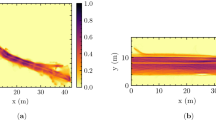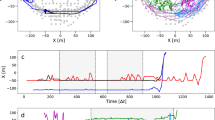Abstract
Having extensively investigated the influence of social bonding on the spatial dynamics of two-people groups (i.e. dyads), we more recently studied the impact of group social relation on the dynamics of individual pedestrians (i.e. non-groups) in their proximity, and, reciprocally, groups’ reaction to such encounters. In the present work, we extend this analysis to additionally study the effect of the groups’ intensity of social interaction (i.e. talking to each other, performing hand gestures, or maintaining eye contact) in similar situations. specifically, using trajectories of uninstructed pedestrians observed in an ecological setting, we analyse encounters between a dyad annotated with an intensity of interaction ranging from 0 (not interacting) to 3 (strongly interacting) and a non-group coming in the opposite direction. We compute the undisturbed minimum distance between them and compare it to the actual minimum distance. To account for the correlation between the intensity of interaction and the size of a group (i.e. the interpersonal distance between the group’s members), the two distances are normalized by the average size of groups with similar intensities of interaction. In line with our previous findings, we demonstrate that avoidance dynamics is more pronounced for groups with higher levels of interaction, while groups that interact less, or not at all, are more likely to be intruded into.
Access this chapter
Tax calculation will be finalised at checkout
Purchases are for personal use only
Preview
Unable to display preview. Download preview PDF.
Similar content being viewed by others
References
Alahi, A., Goel, K., Ramanathan, V., Robicquet, A., Fei-Fei, L., Savarese, S.: Social LSTM: Human trajectory prediction in crowded spaces. In: Proc. IEEE Conf. Computer Vision and Pattern Recognition (2016). DOI https://doi.org/10.1109/CVPR.2016.110
Brščić, D., Kanda, T., Ikeda, T., Miyashita, T.: Person tracking in large public spaces using 3-d range sensors. IEEE Transactions on Human-Machine Systems 43(6), 522–534 (2013). DOI https://doi.org/10.1109/THMS.2013.2283945
Gupta, A., Johnson, J., Fei-Fei, L., Savarese, S., Alahi, A.: Social gan: Socially acceptable trajectories with generative adversarial networks. In: Proc. IEEE/CVF Conf. Computer Vision and Pattern Recognition, pp. 2255–2264. IEEE (2018). DOI https://doi.org/10.1109/CVPR.2018.00240
Helbing, D., Molnar, P.: Social force model for pedestrian dynamics. Physical Review E 51(5), 4282–4286 (1995). DOI https://doi.org/10.1103/physreve.51.4282
Hu, Y., Zhang, J., Song, W., Bode, N.W.F.: Social groups barely change the speed-density relationship in unidirectional pedestrian flow, but affect operational behaviours. Safety Science 139, 105259 (2021). DOI https://doi.org/10.1016/j.ssci.2021.105259
Hu, Y., Zhang, J., Xiao, H., Cao, S., Ren, X., Liang, X., Li, H., Song, W.: Experimental study and analysis on behaviours and strategies of social groups and individuals. Safety Science 127, 104736 (2020). DOI https://doi.org/10.1016/j.ssci.2020.104736
von Krüchten, C., Schadschneider, A.: Empirical study on social groups in pedestrian evacuation dynamics. Physica A: Statistical Mechanics and its Applications 475, 129–141 (2017). DOI https://doi.org/10.1016/j.physa.2017.02.004
McPhail, C., Wohlstein, R.T.: Using film to analyze pedestrian behavior. Sociological Methods and Research 10(3), 347–375 (1982). DOI https://doi.org/10.1177/0049124182010003007
von Sivers, I., Templeton, A., Künzner, F., Köster, G., Drury, J., Philippides, A.O., Neckel, T., Bungartz, H.J.: Modelling social identification and helping in evacuation simulation. Safety Science 89, 288–300 (2016). DOI https://doi.org/10.1016/j.ssci.2016.07.001
Xie, W., Lee, E.W.M., Li, T., Shi, M., Cao, R., Zhang, Y.: A study of group effects in pedestrian crowd evacuation: Experiments, modelling and simulation. Safety Science 133, 105029 (2021). DOI https://doi.org/10.1016/j.ssci.2020.105029
Yücel, Z., Zanlungo, F., Shiomi, M.: Modeling the impact of interaction on pedestrian group motion. Advanced Robotics 32(3), 137–147 (2018). DOI https://doi.org/10.1080/01691864.2017.1421481
Zanlungo, F., Crociani, L., Yücel, Z., Kanda, T.: The effect of social groups on the dynamics of bi-directional pedestrian flow: A numerical study. In: Traffic and Granular Flow 2019, pp. 307–313. Springer International Publishing (2020). DOI https://doi.org/10.1007/978-3-030-55973-1 38
Zanlungo, F., Ikeda, T., Kanda, T.: Potential for the dynamics of pedestrians in a socially interacting group. Physical Review E 89, 012811 (2014). DOI https://doi.org/10.1103/PhysRevE.89.012811
Zanlungo, F., Yücel, Z., Brščić, D., Kanda, T., Hagita, N.: Intrinsic group behaviour: Dependence of pedestrian dyad dynamics on principal social and personal features. PLOS ONE 12(11), e0187253 (2017). DOI https://doi.org/10.1371/journal.pone.0187253
Zhang, B., Chen, W., Ma, X., Qiu, P., Liu, F.: Experimental study on pedestrian behavior in a mixed crowd of individuals and groups. Physica A: Statistical Mechanics and its Applications 556, 124814 (2020). DOI https://doi.org/10.1016/j.physa.2020.124814
Zhang, B., Gao, Y., Han, Y., Liang, S., Chen, Q., Yu, Z.: Walking characteristics and collision avoidance strategy in bidirectional pedestrian flow: a study focused on the influence of social groups. Journal of Statistical Mechanics: Theory and Experiment 2022(7), 073405 (2022). DOI https://doi.org/10.1088/1742-5468/ac7e41
Author information
Authors and Affiliations
Corresponding author
Editor information
Editors and Affiliations
Rights and permissions
Copyright information
© 2024 The Author(s), under exclusive license to Springer Nature Singapore Pte Ltd.
About this paper
Cite this paper
Gregorj, A., Yücel, Z., Zanlungo, F., Kanda, T. (2024). On the Influence of Group Social Interaction on Intrusive Behaviours. In: Rao, K.R., Seyfried , A., Schadschneider, A. (eds) Traffic and Granular Flow '22 . TGF 2022. Lecture Notes in Civil Engineering, vol 443. Springer, Singapore. https://doi.org/10.1007/978-981-99-7976-9_15
Download citation
DOI: https://doi.org/10.1007/978-981-99-7976-9_15
Published:
Publisher Name: Springer, Singapore
Print ISBN: 978-981-99-7975-2
Online ISBN: 978-981-99-7976-9
eBook Packages: EngineeringEngineering (R0)




